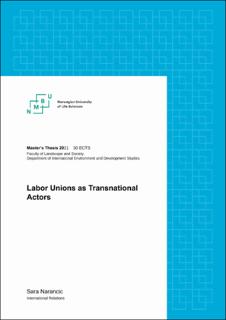| dc.description.abstract | This has been a macro-level qualitative study exploring low-level (nationally and locally) based labor unions’ transnational capabilities. To guide the research, I asked how national labor unions function as transnational actors, and my question was guided by questions regarding what characterizes labor unions’ transnational activities, and what possibilities or constraints they are faced with in the international world. To answer my research question, I firstly outlined the economic landscape which labor unions operate within, followed by a theoretical debate on what labor unions are, what they do, what their structure looks like, what solidarity means in a labor unions context, and what issues labor unions face internationally. I used the case of the Indian farmers’ movement, which began in September of 2020 with the introduction of three new farming-related bills, as an illustrative case to grasp at a contemporary labor issue or international scope. | en_US |

